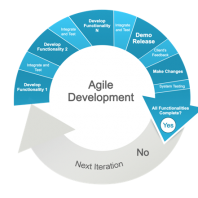‘Agile’ is a set of approaches founded on the basic philosophies of customer and team collaborative working, self organized teams, and the delivery of software incrementally through an iterative approach.
A brief history of Agile
Agile methodologies, especially Scrum, have been influenced largely by Lean Production techniques, which were introduced in the Toyota Production System by Taiichi Ohno. The Toyota production system employs lean thinking which has four principles:
• Add nothing but value (Eliminate waste)
• Centre (Focus) on the people who actually add value
• Flow value from demand (delay commitment)
• Optimize as a theme across organizations
The first step in lean thinking is to get a good understanding of what is value which further leads to an understanding of what is waste and then find the activities and resources that are necessary to create this value. This thought is implemented in all Agile methodologies in some way or the other.
The Agile manifesto for software development was incubated in February 2001 at Utah, USA. There are many popular implementations of Agile methodology. They are Scrum, XP (eXtreme Programming), DSDM (Dynamic Systems Development Model), FDD (Feature Driven Development), Crystal and RUP (Rational Unified Process). Of these, Scrum and Scrum with XP are the most popular methods in use in the industry worldwide
Building high technology, competitive systems is a complicated exercise. This becomes more complex as requirements are often hazy and technology changes rapidly. There is also a market demand as well as a competitive need, to reduce the time-to-release of software artifacts. Conventional thinking and methods such as Waterfall method etc., are not sufficient to proactively manage these aspects. Therefore, companies across the globe are using Agile methods and Scrum for self-organizing, self-managed, cross-functional teams to handle the complexity that is inherent in today’s software projects.
Certifications in SCRUM
Certified Scrum Developer (CSD)
A minimum of five days of formal training is needed to get a Certified Scrum Developer credential. An applicant should be able to demonstrate a good understanding of agile practices by passing a formal CSD assessment.
Certified Scrum Master (CSM)
Currently, an individual is a Certified Scrum Master when he or she has attended, participated in, and completed a Certified ScrumMaster course, and passed/completed the CSM online evaluation. A Certified ScrumMaster (CSM) is someone who has been taught (by a Certified Scrum Trainer) the Scrum terminology, practices, and principles that will enable them to fulfil the role of ScrumMaster or Scrum team member. A Certified ScrumMaster course is a first step on the path to growing more agile. Experience and continuing education are necessary next steps to become a true, practicing Scrum professional. To demonstrate deep understanding and experience with Scrum, CSMs are encouraged to apply for and become Certified Scrum Professionals.
Certified Scrum Product Owner (CSPO)
A Certified Scrum Product Owner (CSPO) is an individual who has been taught (by a Certified Scrum Trainer) the Scrum terminology, practices, and principles that will enable them to fulfil the role of Product Owner for a Scrum team. A Certified Scrum Product Owner course is a first step on the path to growing more agile. Experience and continuing education are necessary for someone to truly master Scrum. To demonstrate deep understanding and experience with Scrum, CSPOs are encouraged to apply for and become Certified Scrum Professionals.
Certified Scrum Professional
A Certified Scrum Professional has proven experience and expertise in the art of Scrum. This is the major level of certification that any practitioners of Scrum must strive to attain. Before becoming a CSP, applicants must be CSMs, CSPOs, or CSDs.
Benefits of SCRUM Certification:
As with any certification, SCRUM certification too differentiates the amateurs from the professionals. Specifically, a course, which is organized by Certified SCRUM Trainers will help leverage Scrum to optimise value creation and customer satisfaction. It will help define a realistic release plan, stock the product backlog, write user stories and refine requirements. Change management associated with implementing Scrum in your organization is also covered in the course content.
Suggested References:
The following are some useful web sites for additional information and reference:
• https://www.Scrumalliance.org
• https://www.agilealliance.org
• https://www.controlchaos.com
• https://scrum.jeffsutherland.com
• https://www.allaboutagile.com
• https://www.implementingscrum.com
• https://www.gettingagile.com
The following are some good books on Agile/Scrum:
• “Do Better Scrum”, by Peter Hundermark: Provides a set of tips and insights into how to do Scrum well.
• “The Scrum Primer” written by Pete Deemer and team
• “The Scrum Papers”, compiled by Jeff Sutherland, one of the co-creators of Scrum.
• “Simple Scrum”, by Tobias Mayer. A domain-independent overview of the Scrum framework
YouTube
For details regarding upcoming trainings in Agile n Scrum please visit:
https://www.bookmytrainings.com/agile-scrum-trainings
[lastupdated]
